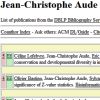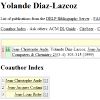| |
|
| |
|
| |

François-Joseph Lapointe. How to account for reticulation events in phylogenetic analysis: A review of distance-based methods. In Journal of Classification, Vol. 17:175-184, 2000.
Keywords: abstract network, evaluation, from distances, phylogenetic network, Program Pyramids, Program SplitsTree, Program T REX, pyramid, reconstruction, reticulogram, split network, survey, weak hierarchy.
Note: http://dx.doi.org/10.1007/s003570000016.
|
|
| |
|
| |
|
| |
|
| |
  
Mark Clement,
David Posada and
Keith A. Crandall. TCS: a computer program to estimate gene genealogies. In MOLE, Vol. 9:1657-1659, 2000.
Keywords: from sequences, parsimony, phylogenetic network, phylogeny, Program TCS, reconstruction, software, statistical parsimony.
Note: http://darwin.uvigo.es/download/papers/08.tcs00.pdf.
Toggle abstract
[No abstract available]
|
|
| |
  
Hans-Jürgen Bandelt,
Vincent Macaulay and
Martin Richards. Median networks: speedy construction and greedy reduction, one simulation, and two case studies from human mtDNA. In MPE, Vol. 16:8-28, 2000.
Keywords: from sequences, from splits, median network, phylogenetic network, phylogeny, reconstruction.
Note: http://www.stats.gla.ac.uk/~vincent/papers/speedy.pdf.
Toggle abstract
"Molecular data sets characterized by few phylogenetically informative characters with a broad spectrum of mutation rates, such as intraspecific control-region sequence variation of human mitochondrial DNA (mtDNA), can be usefully visualized in the form of median networks. Here we provide a step-by-step guide to the construction of such networks by hand. We improve upon a previously implemented algorithm by outlining an efficient parametrized strategy amenable to large data sets, greedy reduction, which makes it possible to reconstruct some of the confounding recurrent mutations. This entails some postprocessing as well, which assists in capturing more parsimonious solutions. To simplify the creation of the resulting network by hand, we describe a speedy approach to network construction, based on a careful planning of the processing order. A coalescent simulation tailored to human mtDNA variation in Eurasia testifies to the usefulness of reduced median networks, while highlighting notorious problems faced by all phylogenetic methods in this context. Finally, we discuss two case studies involving the comparison of characters in the two hypervariable segments of the human mtDNA control region in the light of the worldwide control-region sequence database, as well as additional restriction fragment length polymorphism information. We conclude that only a minority of the mutations that hit the second segment occur at sites that would have a mutation rate comparable to those at most sites in the first segment. Discarding the known 'noisy' sites of the second segment enhances the analysis. (C) 2000 Academic Press."
|
|
| |
 
Katharina Huber,
Elizabeth E. Watson and
Mike Hendy. An Algorithm for Constructing Local Regions in a Phylogenetic Network. In MPE, Vol. 19(1):1-8, 2000.
Keywords: abstract network, median network, phylogenetic network, phylogeny, reconstruction, split.
Note: http://dx.doi.org/10.1006/mpev.2000.0891.
Toggle abstract
"The groupings of taxa in a phylogenetic tree cannot represent all the conflicting signals that usually occur among site patterns in aligned homologous genetic sequences. Hence a tree-building program must compromise by reporting a subset of the patterns, using some discriminatory criterion. Thus, in the worst case, out of possibly a large number of equally good trees, only an arbitrarily chosen tree might be reported by the tree-building program as" The Tree." This tree might then be used as a basis for phylogenetic conclusions. One strategy to represent conflicting patterns in the data is to construct a network. The Buneman graph is a theoretically very attractive example of such a network. In particular, a characterization for when this network will be a tree is known. Also the Buneman graph contains each of the most parsimonious trees indicated by the data. In this paper we describe a new method for constructing the Buneman graph that can be used for a generalization of Hadamard conjugation to networks. This new method differs from previous methods by allowing us to focus on local regions of the graph without having to first construct the full graph. The construction is illustrated by an example. © 2001 Academic Press."
|
|
| |
 
Tao Sang and
Yang Zhong. Testing Hybridization Hypotheses Based on Incongruent Gene Trees. In Systematic Biology, Vol. 49(3):422-434, 2000.
Keywords: bootstrap, from rooted trees, hybridization, lateral gene transfer, lineage sorting, phylogenetic network, phylogeny, reconstruction, statistical model.
Note: http://dx.doi.org/10.1080/10635159950127321.
|
|
| |
|
| |
|
| |
 
Vincent Berry and
David Bryant. Faster reliable phylogenetic analysis. In RECOMB99, Pages 59-68, 1999.
Keywords: abstract network, from quartets, phylogenetic network, phylogeny, polynomial, Program SplitsTree, reconstruction, split network, weakly compatible.
Note: http://citeseerx.ist.psu.edu/viewdoc/summary?doi=10.1.1.95.9151.
|
|
| |
   
Jean-Christophe Aude,
Yolande Diaz-Lazcoz,
Jean-Jacques Codani and
Jean-Loup Risler. Applications of the Pyramidal Clustering Method to Biological Objects. In CC, Vol. 23(3-4):303-315, 1999.
Keywords: from distances, phylogenetic network, phylogeny, Program Pyramids, pyramid, reconstruction, software, visualization.
Note: http://dx.doi.org/10.1016/S0097-8485(99)00006-6.
|
|
| |
|
| |

W. Ford Doolittle. Phylogenetic Classification and the Universal Tree. In Science, Vol. 284:2124-2128, 1999.
Note: http://cas.bellarmine.edu/tietjen/Ecology/phylogenetic_classification_and_.htm.
Toggle abstract
"From comparative analyses of the nucleotide sequences of genes encoding ribosornal RNAs and several proteins, molecular phylogeneticists have constructed a 'universal- tree of life,' taking it as the basis for a 'natural' hierarchical classification of all living things. Although confidence in some of the tree s early branches has recently been shaken, new approaches could still resolve many methodological uncertainties. More challenging is evidence that most archaeal and bacterial genomes (and the inferred ancestral eukaryotic nuclear genome) contain genes from multiple sources. If 'chimerism' or 'lateral gene transfer' cannot be dismissed as trivial in extent or limited to special categories of genes, then no hierarchical universal classification can be taken as natural. Molecular phylogeneticists will have failed to find the 'true tree,' not because their methods are inadequate or because they have chosen the wrong genes, but because the history of life cannot properly be represented as a tree. However, taxonomies based on molecular sequences will remain indispensable, and understanding of the evolutionary process will ultimately be enriched, not impoverished."
|
|
| |
  
Bin Ma,
Lusheng Wang and
Ming Li. Fixed topology alignment with recombination. In CPM98, Vol. 1448:174-188 of LNCS, springer, 1998.
Keywords: approximation, explicit network, from network, from sequences, galled tree, inapproximability, phylogenetic network, phylogeny, recombination.
Note: http://dx.doi.org/10.1007/BFb0030789.
|
|
| |
|
| |
|
| |
 
Roderic D.M. Page and
Michael A. Charleston. Trees within trees: phylogeny and historical associations. In TEE, Vol. 13(9):356-359, 1998.
Keywords: duplication, explicit network, from rooted trees, from species tree, lateral gene transfer, phylogenetic network, phylogeny, reconstruction, survey.
Note: http://taxonomy.zoology.gla.ac.uk/rod/papers/tree.pdf.
|
|
| |
|
| |
|
| |
|
| |
|
| |
|
| |
  
Andreas W. M. Dress,
Daniel H. Huson and
Vincent Moulton. Analyzing and visualizing distance data using SplitsTree. In DAM, Vol. 71(1):95-109, 1996.
Keywords: abstract network, from distances, phylogenetic network, phylogeny, Program SplitsTree, software, split network, visualization.
Note: http://bibiserv.techfak.uni-bielefeld.de/splits/splits.pdf.
|
|
| |
|
| |
|
| |
|
| |
|
|